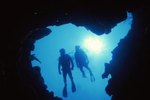
Dolphins, highly intelligent and active mammals, utilize sonar to their advantage when navigating through the ocean. Sonar is also referred to as echolocation, and it provides dolphins with an advantage of hearing and detecting things with precision. Apart from detecting objects in the water, dolphins also depend on sonar to communicate with one another, including their young. Sonar not only helps dolphins to hear, but it gives them a clearer picture of objects underwater.
Sound Depiction
Dolphins' ultra-sensitive sonar allows them to glide through waters while making sense of the sounds in their underwater environment. Dolphins send out "clicks" that are delivered from nasal sacs in their forehead. The focused noise is directed toward a specific object in the water by the dolphin. The sound wave then travels back to the dolphin like an echo, giving him much-needed information regarding the size, shape and distance of the object in question.
Communication
Outgoing and highly bonded to their family members, dolphins communicate with one another throughout their days. Sonar is important in allowing dolphins to send out clicks, trills and whistles to one another. When a dolphin is in his infancy, his mother may send him the same whistle over and over again to leave an "imprint." The unique whistle she sends for him is helpful to get his attention and keep her baby close by.
Locating Objects
When a dolphin wants to locate something in the water, he can do so with precision. He sends out a click by using the nasal sacs located in his forehead. The click can be sent out across the water in various directions and frequencies. Science Daily reports that marine biologists are still carrying out research to identify how dolphins use ecolocation and that more research is needed in order to fully understand it.
More Than Meets the Eye
In many ways, echolocation allows a dolphin to "see" objects underwater in a magnified way. Echolocation gives dolphins detailed information about an object, such as its internal structure speed. There is still much to learn about dolphins' use of echolocaton and how it benefits them in their everyday lives. According to the website Dolphin Kind, some researchers hypothesize that dolphins view objects in their environments holographically and are able to emit these images to other dolphins who are traveling close by.
References
Photo Credits
-
NA/AbleStock.com/Getty Images
Writer Bio
Pamela Miller has been writing for health, beauty and animal health/welfare publications for seven years. Miller holds a Bachelor of Science in Organizational Communication from MTSU.




